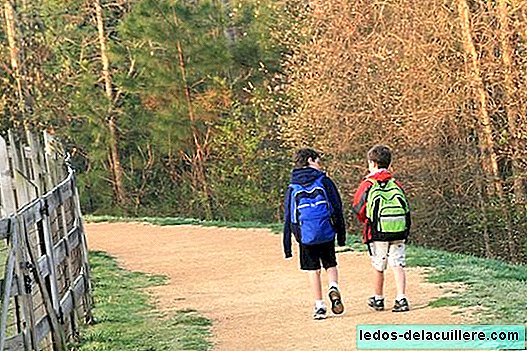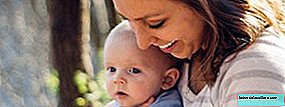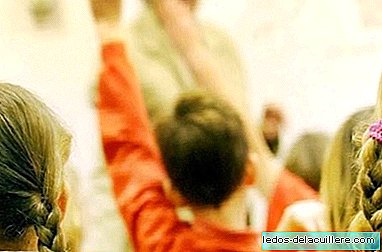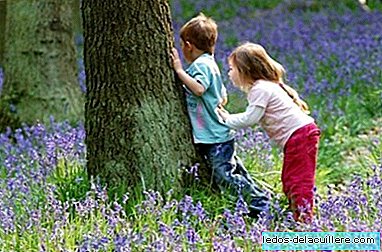Whenever we talk about education we lock ourselves in a classroom, we get carried away by the majority trend but it is not the only way to educate, much less.
There are other schools rooted in nature, there are other stories and there are other ideas that perhaps could be taken to the traditional classroom. The perfect mix between what we have and what we lack.
Open the classroom doors to the forest, to nature, a way of educating closer to the earth, quieter, more leisurely. The forest school as a groundbreaking way of teaching and yet as old as humanity itself.
The forest school

Yes, of course it may seem to us a breakthrough and novel idea and Rupturist may be but novel not so much.
Thinking about it, the forest schools, as they are called, have an origin as old as the human being, that children play in the forest, in the countryside, in a group and under the distant and attentive care of an adult is not something now but of the very principle of humanity, we could say.
They arise for the first time in Denmark When Ella Flatau, she went out every day to the forest with her young son and some children from her neighborhood. Little by little the group was growing until the fathers and mothers themselves organized to form what would be the first children's forest school in Europe in 1952.
In Germany there are about a thousand registered and in the United Kingdom there are more than 12,000 teachers who have been trained in forest schools. In Spain we broke records but just the opposite way, they don't even reach half a dozen the forest schools that are functioning in our country at this time or of which we have proof.
What is a forest school
We could present in a simple way the five fundamental pillars on which a forest school is based.
The children are in nature every day
Every day throughout the year highlighting the maximum of that "There is no bad weather but inadequate clothing." Children live the passage of the seasons, nobody has to tell them, nor do they have to read a book. In countries colder than ours it is shown that children who go to forest schools do not get sick more than the rest of children because in nature they strengthen their immune system.
The forest is the classroom
No facilities beyond a canopy or a roof to leave the backpacks in the morning or to have a hot breakfast before starting the day if the day is colder than usual. There are no books or toys. The classroom is the whole forest and the toys are in the nature and creativity of the children. What there can be are tools that help dig and explore students, buckets and shovels, for example.
The rhythm is marked by children
They are usually organized sitting all in a circle commenting something, singing or with a game and then: to the forest where the rhythm will always be marked by children. When the day ends, a kind of farewell and thanksgiving ritual is usually done. The respect for the environment is fundamental, as much as the slogan of leaving the forest as we find it or if it can be even better, since garbage left by previous visitors can be collected and that will also be part of the learning.

Freedom
Because the rhythm as we said marks each child and There is neither a program to follow nor any planned activities. The educators observe the children, accompany them and take care of them so that they do not get lost, they mediate in the conflicts if they occur, listen, comfort if necessary, accompany and contribute what the children cannot obtain for themselves.
The game is also free and spontaneous. Earth, water, stones, branches, ... are the main pedagogical resources and curiosity, creativity and fantasy are the motor of learning that is stimulated in children who go to forest schools.
The learning
No, conventional subjects or content previously structured and defined by academic authorities are not taught, Children learn by themselves or be first hand, they live it or tell it or read it in books.
What is demonstrated by different studies that have been carried out over the years, is that children who have attended this type of schools are above average in terms of creativity, motivation, concentration, understanding and reasoning. it means.
Children who have attended the forest schools develop a better balance in general, a manual ability, a physical coordination, a tactile sensitivity and a perception of depth higher than the rest and among the smallest who attend this type of schools, they develop a greater capacity to avoid injuries, less stress and better withstand adverse situations, and also increase their attention span.
Taking into account that children now spend more and more hours between four walls, surrounded by asphalt, cars and screens, the forest school directly opens a new reality and a new perspective and completely eliminates the possibility of suffering from the new syndrome of our time and among our children: nature deficit disorder, one of the possible causes of the discomfort of many children in our current society, in this sense it is certainly a very revolutionary approach
The best of each
The British education system He has seen the benefits and needs of children and has added his way to life in nature. One day a week the students of primary and primary education change the classrooms through the forest closest to your school.
No, not all schools do it but it is a recent trend that is growing among British schools. There are also associations and private initiatives that offer conventional schools the service of educators and the natural space for these weekly outings.
A known case

It is not exactly how forest schools are raised but the case of Tippi Degré could get very close, she is known as the girl raised as Mowgli by his parents, two French photographers who for work reasons made his daughter's childhood develop in the African continent, in the middle of nature.
In our western eyes he had a wild childhood, his was a natural childhood and adapted to his environment in which he maintained a peaceful coexistence with wild animals, his best friend was a leopard and his "brother" nothing less than an elephant.
Tippi has already passed the twenty-five years and currently lives in France and studies in the Sorbonne but feels African, something logical if we consider that his childhood developed in that continent. Recently your photos of a girl in a book have come to light we could say that autobiographical "Tippi: My book of Africa"


Tippi: My Book of Africa
Today in Amazon for € 16.04










